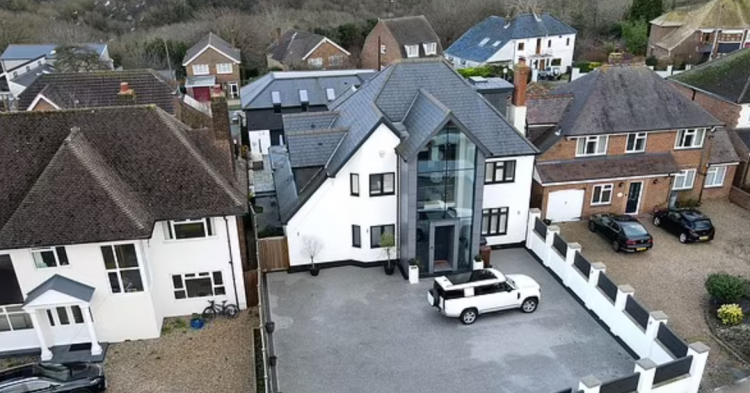In a quiet corner of Chatham, Kent, a 1930s period home has undergone a remarkable transformation, sparking both admiration and criticism from the public. Lucy Peck, a 43-year-old mother of two, and her husband embarked on an ambitious project to renovate their beloved family home, turning it into what they call ‘Peckingham Palace.’ However, their bold architectural choices have ignited controversy, as critics label their creation a ‘chav’ house.
The journey of Peckingham Palace began with a vision to breathe new life into a traditional 1930s home. The Peck family decided to modernize their property by adding a two-story rear extension, an imposing glazed porch, and a spacious driveway. The exterior of the house was transformed from its classic look to a contemporary design, while an outdoor swimming pool and a massive triple garage were added to complete the makeover.
Architects described the finished product as a “large, light, contemporary home.” However, the public reaction was not uniformly positive. The transformation of the house drew a considerable amount of attention when before-and-after photos were shared on social media platforms like Twitter. Comments ranged from sarcastic jabs at the architectural style to outright criticism of what some deemed an “ugly upgrade.”
Despite the mixed reception, Lucy Peck remains unfazed by the negative comments. She told MailOnline, “I don’t care what people say. We are very happy with it. I love it. We love it, and we’re proud of it.” Her confidence and determination in pursuing their vision shine through the criticism. To Mrs. Peck and her family, the happiness they find within their transformed home is what truly matters.
In a world where social media platforms allow for instantaneous and sometimes ruthless commentary, the Peck family stands firm in their belief that their home reflects their personal style and preferences. Mrs. Peck emphasized, “We wanted to move with the times. Don’t get me wrong, it was a beautiful house before. But modern is our style. It’s what we like and go for, and that’s what we have worked towards. And we’re very pleased.”
Mrs. Peck’s sentiment highlights a critical aspect of homeownership—the ability to shape one’s living space according to their own tastes and lifestyle. The couple, who run a scaffolding business, invested significant time and effort into the project, ensuring their involvement in every decision. The end result reflects not just a house but a testament to their hard work and dedication.
One notable aspect of this transformation is its impact on the property’s value. Mrs. Peck mentioned that the house was valued at £520,000 in 2019. After the renovation, its value increased substantially to £1.4 million. While the precise cost of the project remains undisclosed, the rise in value illustrates how such renovations can be financially rewarding.
The Peck family’s neighbors have been supportive of their project, with one neighbor stating, “I think it’s great. I don’t see what the problem with it would be at all. It’s up to them to do what they want at the end of the day.” This perspective underscores the importance of personal choice in home design and renovation.
The architects responsible for the project provided insights into their design process, describing it as “incorporating a large open planned rear extension to create a generous kitchen/dining/living area with an extensive series of bi-fold doors and glazing.” This design aimed to maximize the connection between the interior living space and the newly added external swimming pool, ultimately creating a beautiful 5-bedroom family home that combines relaxation and entertainment.
In an age where individuality and personal expression are celebrated, the Peck family’s journey serves as a reminder that homeowners should feel empowered to shape their living spaces according to their preferences and values. While opinions may differ, the love and pride they feel for their ‘Peckingham Palace’ are ultimately what define the success of their project.
In conclusion, Lucy Peck’s determination to create a home that reflects her family’s style and values has resulted in a striking transformation of a 1930s period house into ‘Peckingham Palace.’ While the renovation has generated mixed reactions from the public, it serves as a testament to the power of personal vision and determination in shaping one’s living space. The Peck family’s story reminds us that a home is not just a structure; it is a canvas for personal expression and a reflection of one’s identity.
